Developing SQL Databases v1.0
Question 1
Note: The question is part of a series of questions that use the same or similar answer choices. An answer choice may be correct for more than one question in the series. Each question is independent of the other question in the series. Information and details provided in a question apply only to that question.
You have a database named DB1. The database does not have a memory optimized filegroup.
You create a table by running the following Transact-SQL statement:

The table is currently used for OLTP workloads. The analytics user group needs to perform real-time operational analytics that scan most of the records in the table to aggregate on a number of columns.
You need to add the most efficient index to support the analytics workload without changing the OLTP application.
What should you do?
- A. Create a clustered indexon the table.
- B. Create a nonclustered index on the table.
- C. Create a nonclustered filtered index on the table.
- D. Create a clustered columnstore index on the table.
- E. Create a nonclustered columnstore index on the table.
- F. Create a hash index on the table.
Answer : E
Explanation:
A nonclustered columnstore index enables real-time operational analytics in which the OLTP workload uses the underlying clustered index, while analytics run concurrently on the columnstore index.
Columnstore indexes can achieve up to 100xbetter performance on analytics and data warehousing workloads and up to 10x better data compression than traditional rowstore indexes. These recommendations will help your queries achieve the very fast query performance that columnstore indexes are designed to provide.
References:
https://msdn.microsoft.com/en-us/library/gg492088.aspx
Question 2
DRAG DROP -
You are analyzing the performance of a database environment.
You suspect there are several missing indexes in the current database.
You need to return a prioritized list of the missing indexes on the current database.
How should you complete the Transact-SQL statement? To answer, drag the appropriate Transact-SQL segments to the correct locations. Each Transact-SQL segment may be used once, more than once or not at all. You may need to drag the split bar between panes or scroll to view content.
Select and Place:
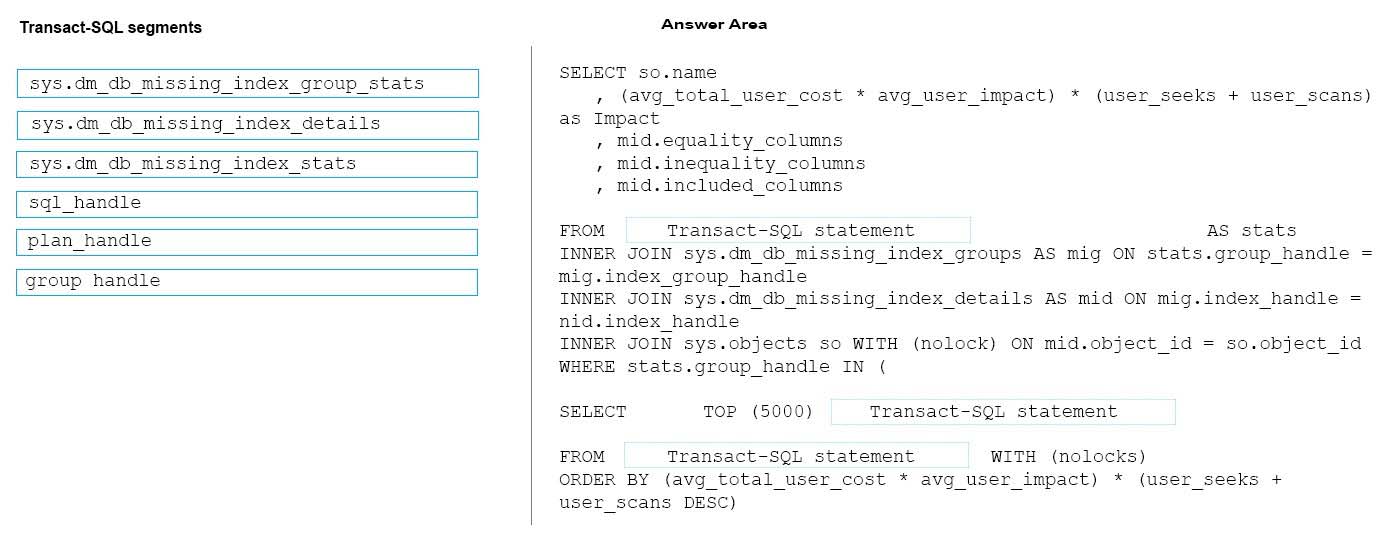
Answer : 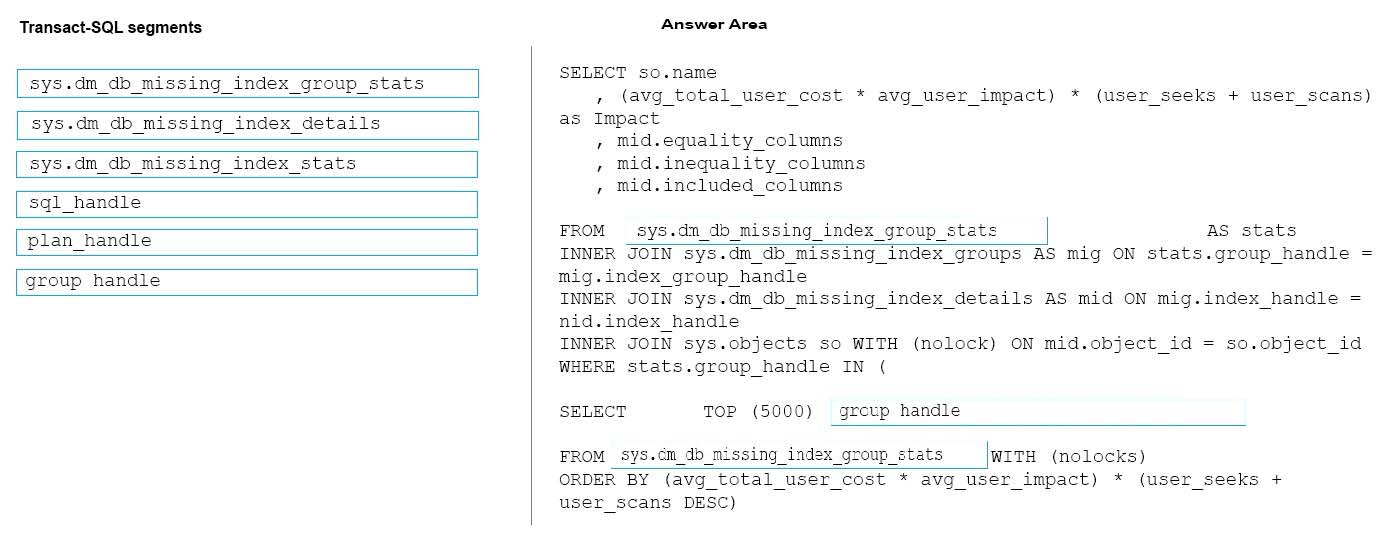
Box 1: sys.db_db_missing_index_group_stats
Box 2: group_handle -
Example: The following query determines which missing indexes comprise a particular missing index group, and displays their column details. For the sake of this example, the missing index group handle is 24.
SELECT migs.group_handle, mid.*
FROM sys.dm_db_missing_index_group_stats AS migs
INNER JOIN sys.dm_db_missing_index_groups AS mig
ON (migs.group_handle = mig.index_group_handle)
INNER JOIN sys.dm_db_missing_index_details AS mid
ON (mig.index_handle = mid.index_handle)
WHERE migs.group_handle = 24;
Box 3: sys.db_db_missing_index_group_stats
The sys.db_db_missing_index_group_stats table include the required columns for the subquery: avg_total_user_cost and avg_user_impact.
Example: Find the 10 missing indexes with the highest anticipated improvement for user queries
The following query determines which 10 missing indexes would produce the highest anticipated cumulative improvement, in descending order, for user queries.
SELECT TOP 10 *
FROM sys.dm_db_missing_index_group_stats
ORDER BY avg_total_user_cost * avg_user_impact * (user_seeks + user_scans)DESC;
Question 3
DRAG DROP -
You are monitoring a Microsoft Azure SQL Database.
The database is experiencing high CPU consumption.
You need to determine which query uses the most cumulative CPU.
How should you complete the Transact-SQL statement? To answer, drag the appropriate Transact-SQL segments to the correct locations. Each Transact-SQL segment may be used once, more than one or not at all. You may need to drag the split bar between panes or scroll to view content.
Select and Place:
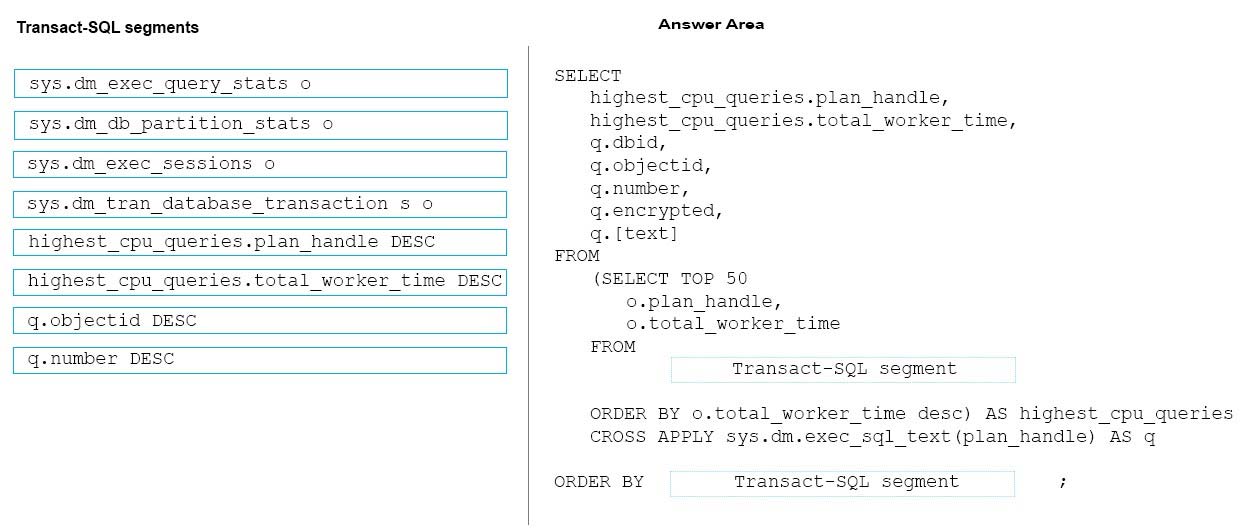
Answer : 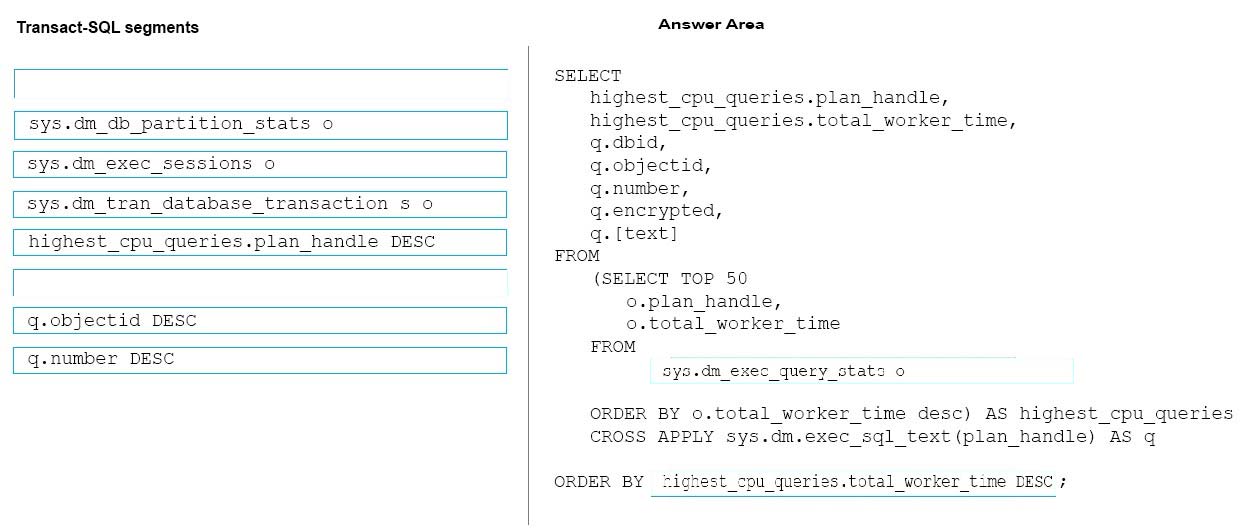
Box 1: sys.dm_exec_query_stats -
sys.dm_exec_query_stats returns aggregateperformance statistics for cached query plans in SQL Server.
Box 2: highest_cpu_queries.total_worker_time DESC
Sort on total_worker_time column
Example: The following example returns information about the top five queries ranked by average CPU time.
Thisexample aggregates the queries according to their query hash so that logically equivalentqueries are grouped by their cumulative resource consumption.
USE AdventureWorks2012;
GO -
SELECT TOP 5 query_stats.query_hash AS "Query Hash",
SUM(query_stats.total_worker_time) / SUM(query_stats.execution_count) AS "Avg CPU Time",
MIN(query_stats.statement_text) AS "Statement Text"
FROM -
(SELECT QS.*,
SUBSTRING(ST.text, (QS.statement_start_offset/2) + 1,
((CASE statement_end_offset
WHEN -1 THEN DATALENGTH(ST.text)
ELSE QS.statement_end_offset END
- QS.statement_start_offset)/2) + 1) AS statement_text
FROM sys.dm_exec_query_stats AS QS
CROSS APPLY sys.dm_exec_sql_text(QS.sql_handle)as ST) as query_stats
GROUP BY query_stats.query_hash -
ORDER BY 2 DESC;
References:
https://msdn.microsoft.com/en-us/library/ms189741.aspx
Question 4
DRAG DROP -
You are analyzing the memory usage of a Microsoft SQL Server instance.
You need to obtain the information described on the following table.

Which performance counter should you use for each requirement? To answer, drag the appropriate performance counters to the correct requirements. Each performance counter may be used once, more than once or not at all. You may need to drag the split bat between panes or scroll to view content.
NOTE: Each correct selection is worth one point.
Select and Place:
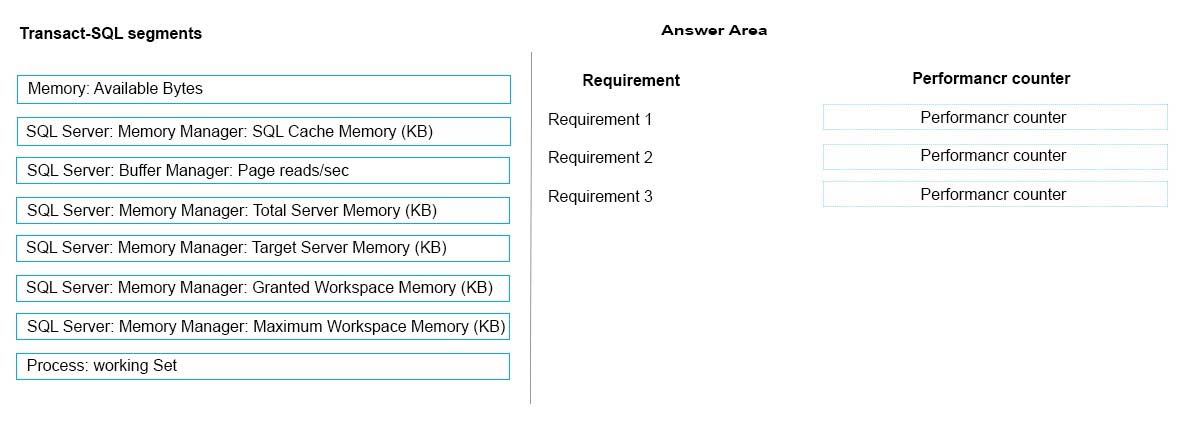
Answer : 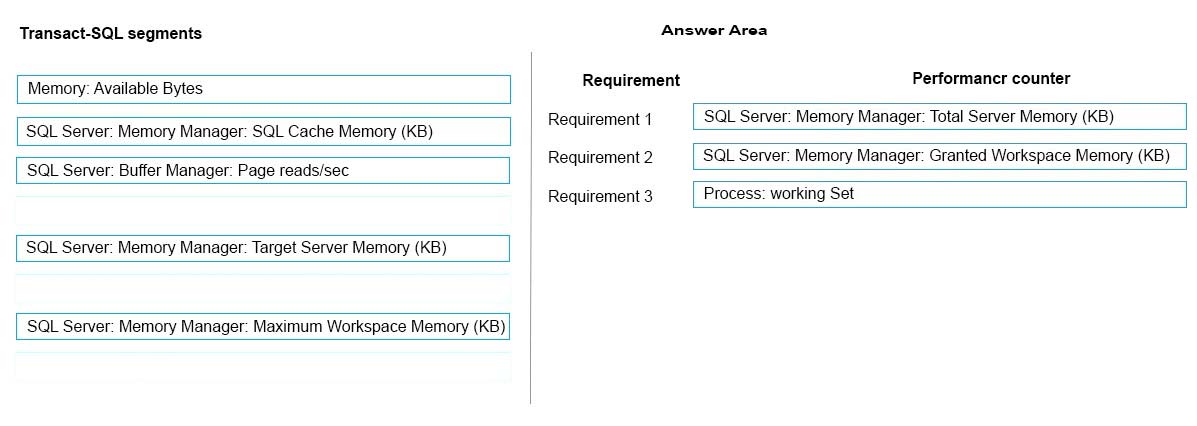
Requirement1: SQL Server: Memory Manager: Total Server Memory (KB)
This counter specifies theamount of memory the server has committed using the memory manager.
Requirement2: SQL Server: Memory Manager: Granted Workspace Memory (KB)
Specifies the total amount of memory currently granted to executing processes, such as hash, sort, bulk copy, andindex creation operations.
Requirement3: Process: working Set
Each time a process is created, it reserves the minimum working set size for the process. The virtual memory manager attempts to keep enough memory for the minimum working set resident when the process is active, but keeps no more than the maximum size.
References:
https://msdn.microsoft.com/en-us/library/ms190924.aspx
https://blogs.technet.microsoft.com/askperf/2007/05/18/sql-and-the-working-set/
Question 5
You use Microsoft SQL Server Profile to evaluate a query named Query1. The Profiler report indicates the following issues:
-> At each level of the query plan, a low total number of rows are processed.
-> The query uses many operations. This results in a high overall cost for the query.
You need to identify the information that will be useful for the optimizer.
What should you do?
- A. Start a SQL Server Profiler trace for the event class Auto Stats in the Performance event category.
- B. Create one Extended Events session with the sqlserver.missing_column_statistics event added.
- C. Start a SQL Server Profiler trace for the event class Soft Warnings in the Errors and Warnings event category.
- D. Create one Extended Events session with the sqlserver.missing_join_predicate event added.
Answer : D
Explanation:
The Missing Join Predicate event class indicates that a query is being executed that has no join predicate. This could result in a long-running query.
Question 6
You are experiencing performance issues with the database server.
You need to evaluate schema locking issues, plan cache memory pressure points, and backup I/O problems.
What should you create?
- A. a System Monitor report
- B. a sys.dm_exec_query_stats dynamic management view query
- C. a sys.dm_exec_session_wait_stats dynamicmanagement view query
- D. an Activity Monitor session in Microsoft SQL Management Studio.
Answer : C
Explanation:
sys.dm_exec_session_wait_stats returns information about all the waits encountered by threads that executed for each session. You can use this view to diagnose performance issues with the SQL Server session and also with specific queries and batches.
Note: SQL Server wait stats are, at their highest conceptual level, grouped into two broad categories: signal waits and resource waits. A signal wait is accumulated by processes running on SQL Server which are waiting for a CPU to become available (so called because the process has "signaled" that it is ready for processing). A resource wait is accumulated by processes running on SQL Server which are waiting fora specific resource to become available, such as waiting for the release of a lock on a specific record.
Question 7
HOTSPOT -
You are maintaining statistics for a database table named tblTransaction. The table contains more than 10 million records.
You need to create a stored procedure that meets the following requirements:
-> On weekdays, update statistics for a sample of the total number of records in the table.
-> On weekends, update statistics by sampling all rows in the table.
A maintenance task will call this stored procedure daily.
How should you complete the stored procedure? To answer, select the appropriate Transact-SQL segments in the answer area.
NOTE: Each correct selection is worth one point.
Hot Area:
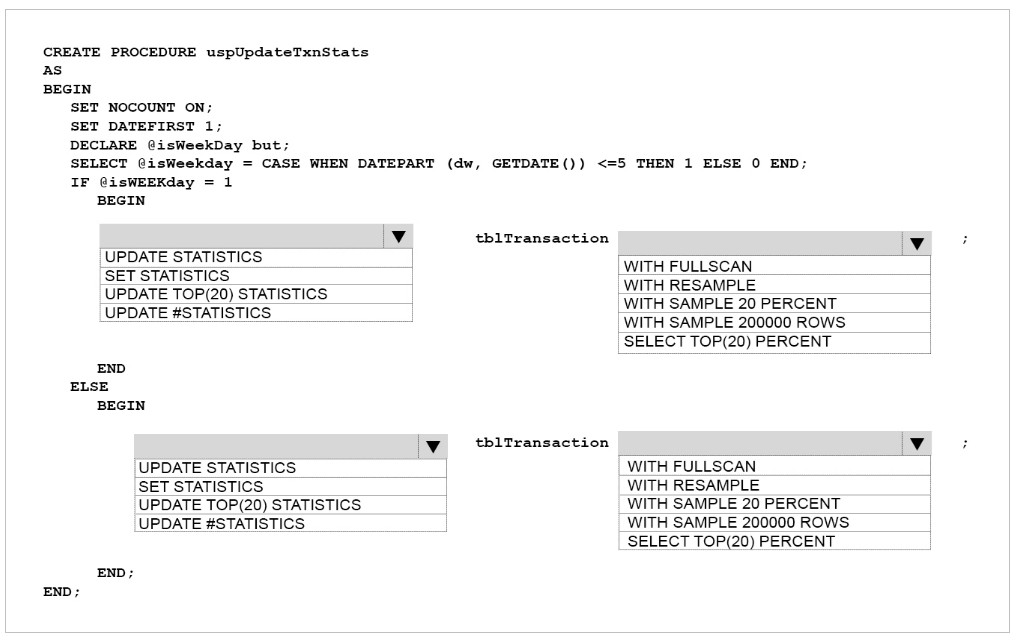
Answer : 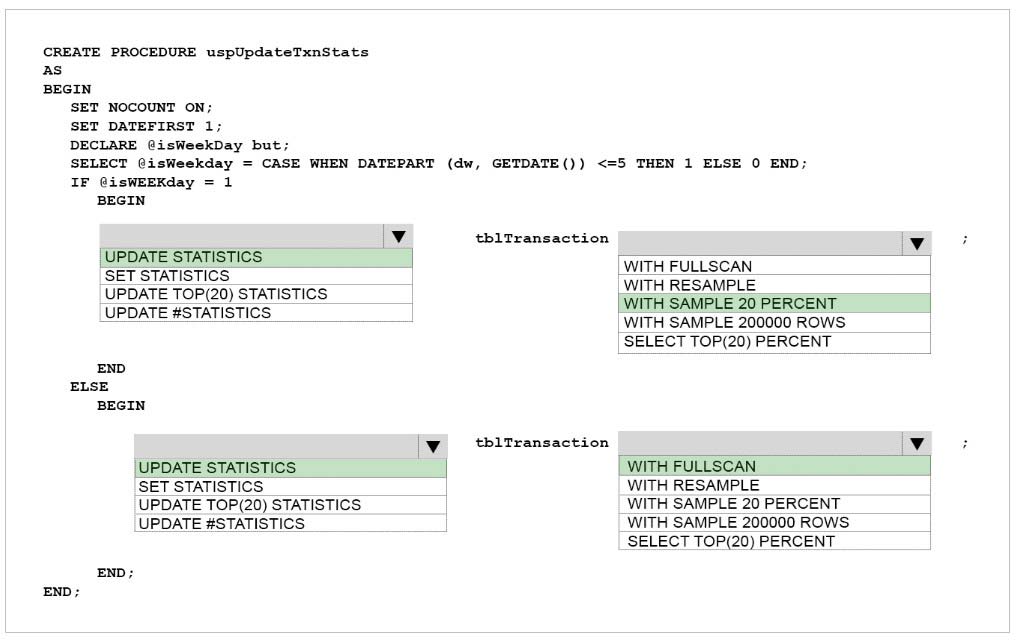
Explanation:
Box 1: UPDATE STATISTICS -
Box 2: SAMPLE 20 PERCENT -
UPDATE STATISTICS tablenameSAMPLE number { PERCENT | ROWS }
Specifies the approximate percentage or number of rows in the table or indexed view for the query optimizer to use when it updates statistics. For PERCENT, number can be from 0 through 100 and for ROWS, number can be from0 to the total number of rows.
Box 3: UPDATE STATISTICS -
Box 4: WITH FULLSCAN -
FULLSCAN computes statistics by scanning all rows in the table or indexed view. FULLSCAN and SAMPLE 100 PERCENT have the same results. FULLSCAN cannot be used with the SAMPLE option.
References:
https://msdn.microsoft.com/en-us/library/ms187348.aspx
Question 8
DRAG DROP -
You have a database named MyDatabase. You must monitor all the execution plans in XML format by using Microsoft SQL Trace. The trace must meet the following requirements:
-> Capture execution plans only for queries that run the MyDatabase database.
-> Filter out plans with event duration of less than or equal to 100 microseconds.
-> Save trace results to a disk on the server.
You need to create the trace.
In which order should you arrange the Transact-SQL segments to develop the solution? To answer, move all Transact-SQL segments to the answer area and arrange them in the correct order.
NOTE: More than one order of answer choices is correct. You will receive credit for any of the correct orders you select.
Select and Place:
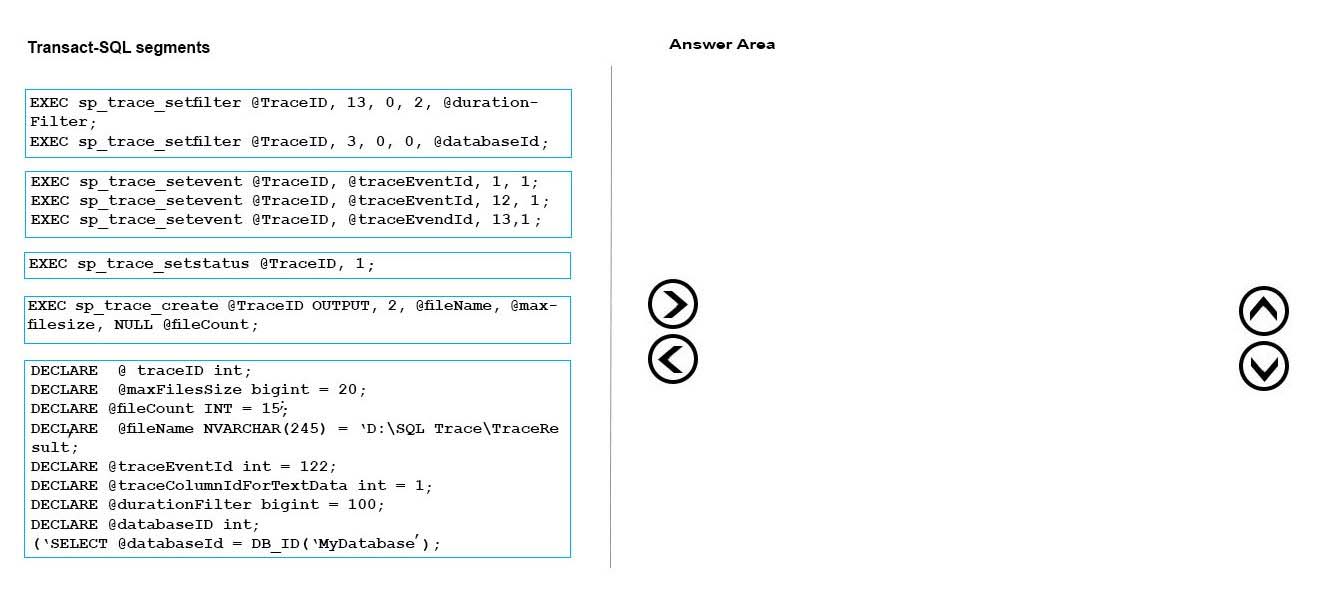
Answer : 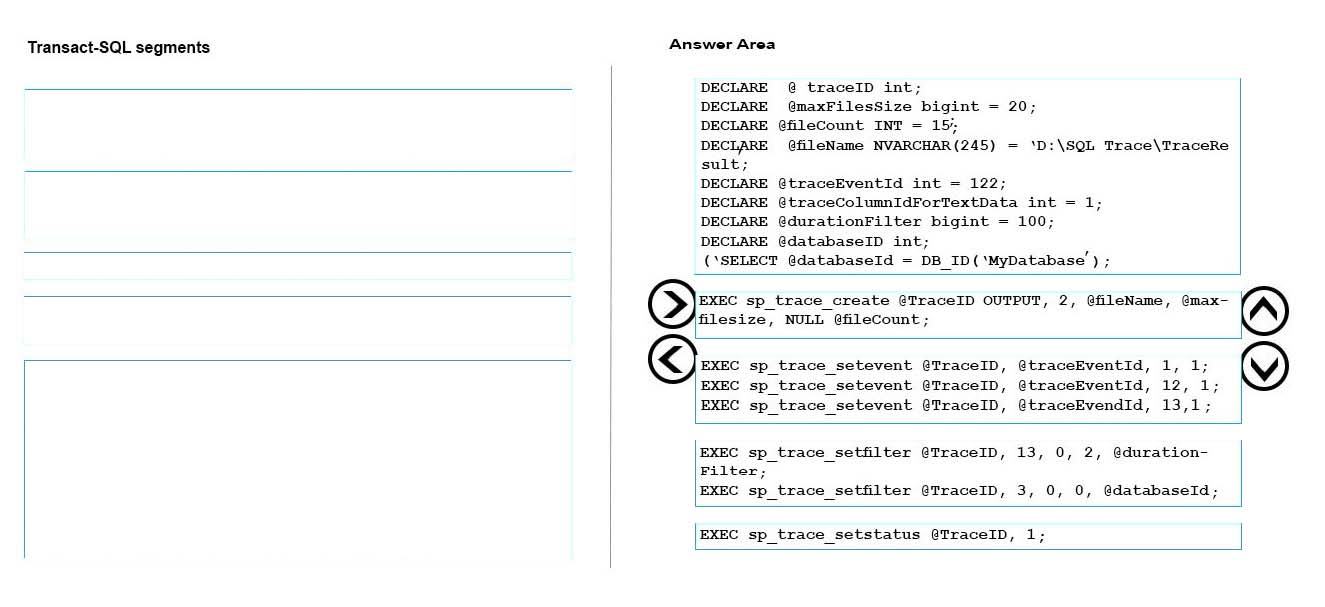
The following system stored procedures are used to define and manage traces:
* sp_trace_create is used to define a trace and specify an output file location as well asother options that I"™ll cover in the coming pages. This stored procedure returns a handle to the created trace, in the form of an integer trace ID.
* sp_trace_setevent is used to add event/column combinations to traces based on the trace ID, as well as toremove them, if necessary, from traces in which they have already been defined.
* sp_trace_setfilter is used to define event filters based on trace columns.
* sp_trace_setstatus is called to turn on a trace, to stop a trace, and to delete a trace definitiononce you"™re done with it. Traces can be started and stopped multiple times over their lifespan.
References:
https://msdn.microsoft.com/en-us/library/cc293613.aspx
Question 9
HOTSPOT -
You are analyzing the performance of a database environment.
You need to find all unused indexes in the current database.
How should you complete the Transact-SQL statement? To answer, select the appropriate Transact-SQL segments in the answer area.
Hot Area:
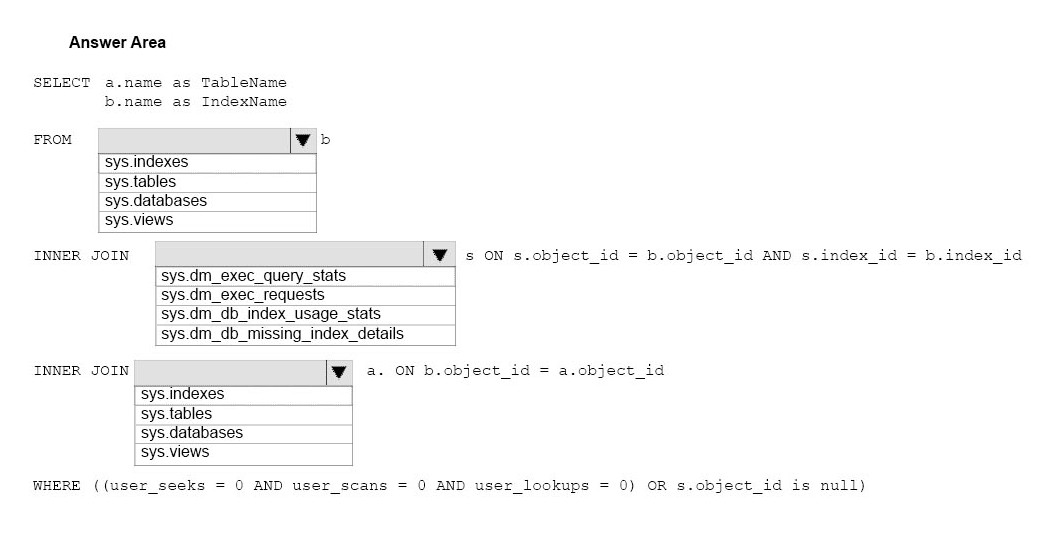
Answer : 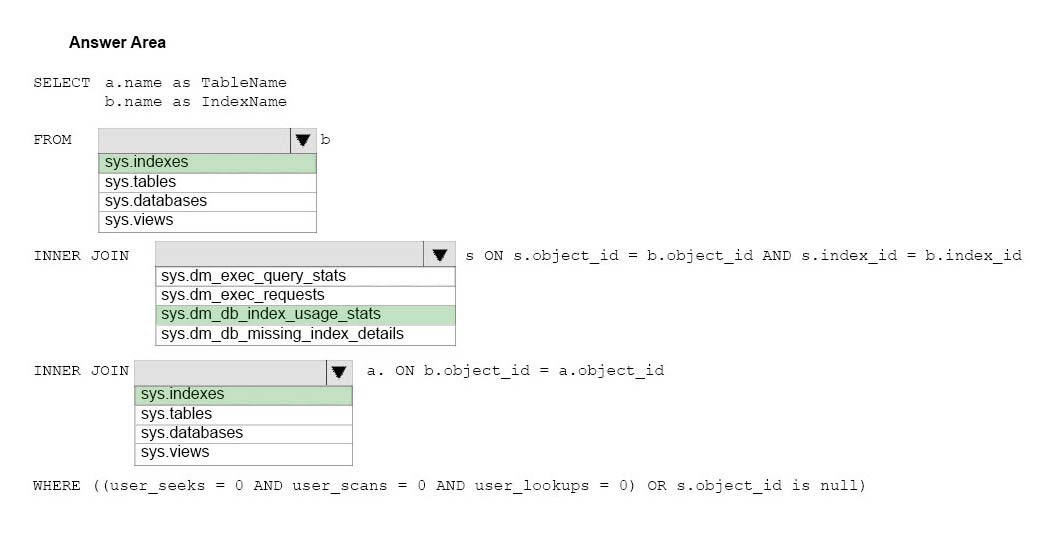
Example: Following query helps you to find all unused indexes within database using sys.dm_db_index_usage_stats DMV.
-- Ensure a USE statement has been executed first.
SELECT u.*
FROM [sys].[indexes] i -
INNER JOIN [sys].[objects] o ON (i.OBJECT_ID = o.OBJECT_ID)
LEFT JOIN [sys].[dm_db_index_usage_stats] u ON (i.OBJECT_ID = u.OBJECT_ID)
AND i.[index_id] = u.[index_id]
AND u.[database_id] = DB_ID() --returning the database ID of the current database
WHERE o.[type] <> 'S' --shouldn't be a system base table
AND i.[type_desc] <> 'HEAP'
AND i.[name] NOT LIKE 'PK_%'
AND u.[user_seeks] + u.[user_scans] + u.[user_lookups] = 0
AND u.[last_system_scan] IS NOT NULL
ORDER BY 1 ASC -
References:
https://basitaalishan.com/2012/06/15/find-unused-indexes-using-sys-dm_db_index_usage_stats/
Question 10
HOTSPOT -
You are reviewing the execution plans in the query plan cache. You observe the following:
- There are a large number of single use plans.
- There are a large number of simple execution plans that use multiple CPU cores.
You need to configure the server to optimize query plan execution.
Which two setting should you modify on the properties page for the Microsoft SQL Server instance? To answer, select the appropriate settings in the answer area.
Hot Area:
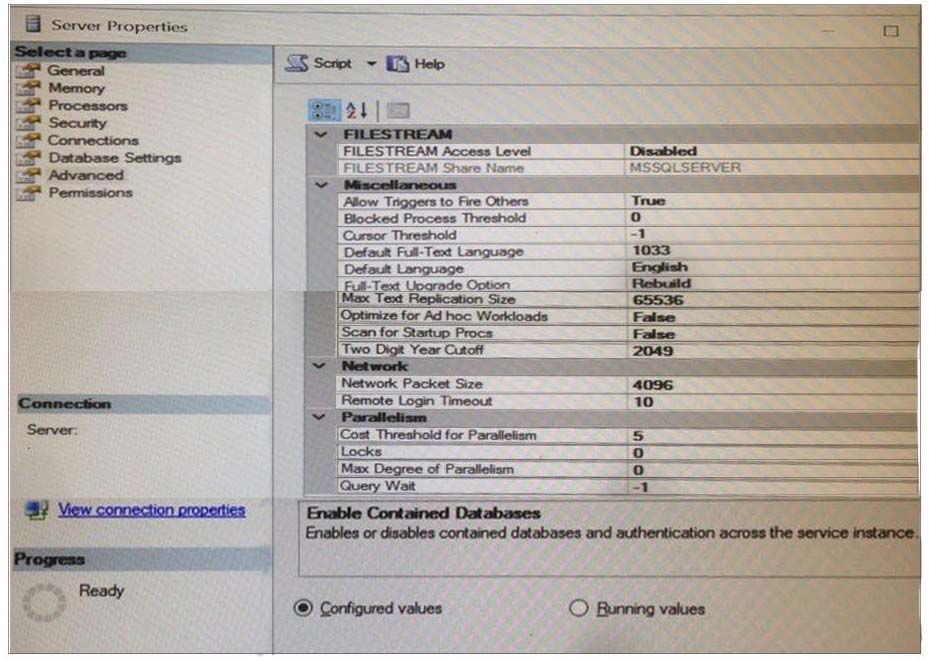
Answer : 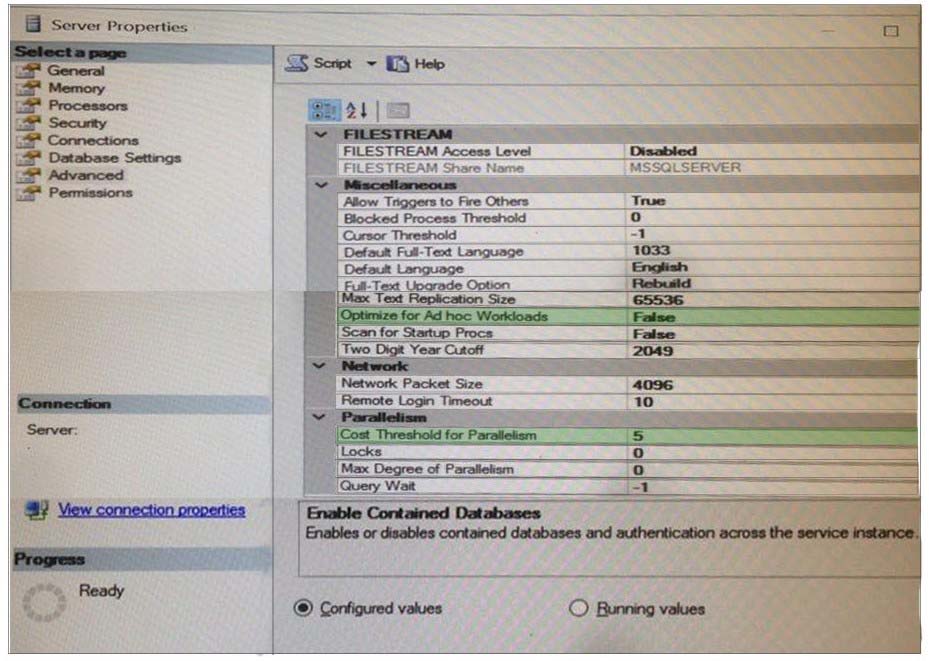
* Optimize for ad hoc workloads
The optimize for ad hoc workloads option is used to improve the efficiency of the plan cache for workloads that contain many single use ad hoc batches. When this option is set to 1, the Database Engine stores a small compiled plan stub in the plan cache when a batch is compiled for the first time, instead of the full compiled plan. This helps to relieve memory pressure by not allowing the plan cache to become filled with compiled plans that are not reused.
* Cost Threshold for Parallelism
Use the cost threshold for parallelism option to specify the threshold at which Microsoft SQL Server creates and runs parallel plans for queries. SQL Server creates and runs a parallel plan for a query only when the estimated cost to run a serial plan for the same query is higher than the value set in cost threshold for parallelism. The cost refers to an estimated elapsed time in seconds required to run the serial plan on a specific hardware configuration.
5 means 5 seconds, but is is 5 seconds on a machine internal to Microsoft from some time in the 1990s. There's no way to relate it to execution time on your current machine, so we treat it as a pure number now. Raising it to 50 is a common suggestion nowadays, so that more of your simpler queries run on a single thread.
Question 11
Note: this question is part of a series of questions that use the same or similar answer choices. An answer choice may be correct for more than one question in the series. Each question is independent of the other questions in the series. Information and details provided in a question apply only to that question.
You are developing an application to track customer sales.
You need to create a database object that meets the following requirements:
- Return a value of 0 if data inserted successfully into the Customers table.
- Return a value of 1 if data is not inserted successfully into the Customers table.
- Support logic that is written by using managed code.
What should you create?
- A. extended procedure
- B. CLR procedure
- C. user-defined procedure
- D. DML trigger
- E. DDL trigger
- F. scalar-valued function
- G. table-valued function
Answer : B
Explanation:
DML triggers is a special type of stored procedure that automatically takes effect when a data manipulation language (DML) event takes place that affects the table or view defined in the trigger. DML events include INSERT, UPDATE, or DELETE statements.DML triggers can be used to enforce business rules and data integrity, query other tables, and include complex Transact-SQL statements.
A CLR trigger is a type of DDL trigger. A CLR Trigger can be either an AFTER or INSTEAD OF trigger. A CLR trigger canalso be a DDL trigger. Instead of executing a Transact-SQL stored procedure, a CLR trigger executes one or more methods written in managed code that are members of an assembly created in the .NET Framework and uploaded in SQL Server.
References:
https://msdn.microsoft.com/en-us/library/ms178110.aspx
Question 12
Note: this question is part of a series of questions that use the same or similar answer choices. An answer choice may be correct for more than one question in the series. Each question is independent of the other questions in the series. Information and details provided in a question apply only to that question.
You are developing an application to track customer sales.
You need to create a database object that meets the following requirements:
- Return a value of 0 if data inserted successfully into the Customers table.
- Return a value of 1 if data is not inserted successfully into the Customers table.
- Support TRY"¦CATCH error handling
- Be written by using Transact-SQL statements.
What should you create?
- A. extended procedure
- B. CLR procedure
- C. user-defined procedure
- D. DML trigger
- E. scalar-valued function
- F. table-valued function
Answer : D
Explanation:
DML triggers is a special type of stored procedure that automatically takes effect when a data manipulation language (DML) event takes place that affects the table or view defined in the trigger. DML events include INSERT, UPDATE, or DELETE statements. DML triggers can be usedto enforce business rules and data integrity, query other tables, and include complex Transact-SQL statements.
References:
https://msdn.microsoft.com/en-us/library/ms178110.aspx
Question 13
Note: this question is part of a series of questions that use the same or similar answer choices. An answer choice may be correct for more than one question in the series. Each question is independent of the other questions in the series. Information and details provided in a question apply only to that question.
You are developing an application to track customer sales.
You need to create a database object that meets the following requirements:
-> Launch when table data is modified.
-> Evaluate the state of a table before and after a data modification and take actions based on the difference.
-> Prevent malicious or incorrect table data operations.
-> Prevent changes that violate referential integrity by cancelling the attempted data modification.
-> Run managed code packaged in an assembly that is created in the Microsoft.NET Framework and located into Microsoft SQL Server.
What should you create?
- A. extended procedure
- B. CLR procedure
- C. user-defined procedure
- D. DML trigger
- E. scalar-valued function
- F. table-valued function
- G. DDL trigger
Answer : B
Explanation:
You can create a database object inside SQL Server that is programmed in an assembly created in the Microsoft .NET Framework common language runtime
(CLR). Database objects that can leverage the rich programmingmodel provided by the CLR include DML triggers, DDL triggers, stored procedures, functions, aggregate functions, and types.
Creating a CLR trigger (DML or DDL) in SQL Server involves the following steps:
Define the trigger as a class in a .NETFramework-supported language. For more information about how to program triggers in the CLR, see CLR Triggers. Then, compile the class to build an assembly in the .NET Framework using the appropriate language compiler.
Register the assembly in SQL Server using the CREATE ASSEMBLY statement. For more information about assemblies in SQL Server, see Assemblies
(Database Engine).
Create the trigger that references the registered assembly.
References:
https://msdn.microsoft.com/en-us/library/ms179562.aspx
Question 14
Note: this question is part of a series of questions that use the same or similar answer choices. An answer choice may be correct for more than one question in the series. Each question is independent of the other questions in the series. Information and details provided in a question apply only to that question.
You are developing and application to track customer sales.
You need to return the sum of orders that have been finalized, given a specified order identifier. This value will be used in other Transact-SQL statements.
You need to create a database object.
What should you create?
- A. extended procedure
- B. CLR procedure
- C. user-defined procedure
- D. DML trigger
- E. scalar-valued function
- F. table-valued function
Answer : F
Explanation:
User-defined scalar functions return a single data value of the type defined in the RETURNS clause.
References:
https://technet.microsoft.com/en-us/library/ms177499(v=sql.105).aspx
Question 15
Note: this question is part of a series of questions that use the same or similar answer choices. An answer choice may be correct for more than one question in the series. Each question is independent of the other questions in the series. Information and details provided in a question apply only to that question.
You are developing and application to track customer sales.
You need to create an object that meet the following requirements:
- Run managed code packaged in an assembly that was created in the Microsoft.NET Framework and uploaded in Microsoft SQL Server.
- Run within a transaction and roll back if a future occurs.
- Run when a table is created or modified.
What should you create?
- A. extended procedure
- B. CLR procedure
- C. user-defined procedure
- D. DML trigger
- E. scalar-valued function
- F. table-valued function
- G. DDL trigger
Answer : B
Explanation:
The common language runtime (CLR) is the heart of the Microsoft .NET Framework andprovides the execution environment for all .NET Framework code. Code that runs within the CLR is referred to as managed code.
With the CLR hosted in Microsoft SQL Server (called CLR integration), you can author stored procedures, triggers, user-defined functions, user-defined types, and user-defined aggregates in managed code. Because managed code compiles to native code prior to execution, you can achieve significant performance increases in some scenarios.